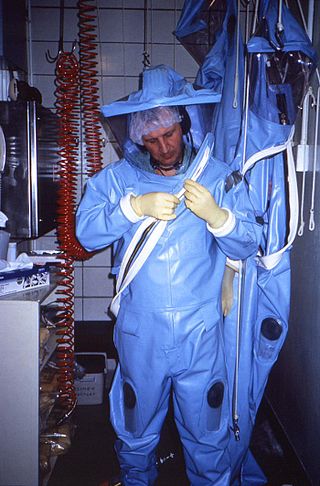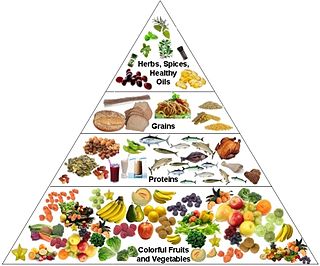
Biosafety is the prevention of large-scale loss of biological integrity, focusing both on ecology and human health. These prevention mechanisms include the conduction of regular reviews of biosafety in laboratory settings, as well as strict guidelines to follow. Biosafety is used to protect from harmful incidents. Many laboratories handling biohazards employ an ongoing risk management assessment and enforcement process for biosafety. Failures to follow such protocols can lead to increased risk of exposure to biohazards or pathogens. Human error and poor technique contribute to unnecessary exposure and compromise the best safeguards set into place for protection.

Epidemiology is the study and analysis of the distribution, patterns and determinants of health and disease conditions in a defined population.
Risk assessment determines possible mishaps, their likelihood and consequences, and the tolerances for such events. The results of this process may be expressed in a quantitative or qualitative fashion. Risk assessment is an inherent part of a broader risk management strategy to help reduce any potential risk-related consequences.
A cohort study is a particular form of longitudinal study that samples a cohort, performing a cross-section at intervals through time. It is a type of panel study where the individuals in the panel share a common characteristic.

Occupational hygiene is the anticipation, recognition, evaluation, control, and confirmation (ARECC) of protection from risks associated with exposures to hazards in, or arising from, the workplace that may result in injury, illness, impairment, or affect the well-being of workers and members of the community. These hazards or stressors are typically divided into the categories biological, chemical, physical, ergonomic and psychosocial. The risk of a health effect from a given stressor is a function of the hazard multiplied by the exposure to the individual or group. For chemicals, the hazard can be understood by the dose response profile most often based on toxicological studies or models. Occupational hygienists work closely with toxicologists for understanding chemical hazards, physicists for physical hazards, and physicians and microbiologists for biological hazards. Environmental and occupational hygienists are considered experts in exposure science and exposure risk management. Depending on an individual's type of job, a hygienist will apply their exposure science expertise for the protection of workers, consumers and/or communities.
In epidemiological research, recall bias is a systematic error caused by differences in the accuracy or completeness of the recollections retrieved ("recalled") by study participants regarding events or experiences from the past. It is sometimes also referred to as response bias, responder bias or reporting bias.
Exposure assessment is a branch of environmental science and occupational hygiene that focuses on the processes that take place at the interface between the environment containing the contaminant of interest and the organism being considered. These are the final steps in the path to release an environmental contaminant, through transport to its effect in a biological system. It tries to measure how much of a contaminant can be absorbed by an exposed target organism, in what form, at what rate and how much of the absorbed amount is actually available to produce a biological effect. Although the same general concepts apply to other organisms, the overwhelming majority of applications of exposure assessment are concerned with human health, making it an important tool in public health.
Environmental epidemiology is a branch of epidemiology concerned with determining how environmental exposures impact human health. This field seeks to understand how various external risk factors may predispose to or protect against disease, illness, injury, developmental abnormalities, or death. These factors may be naturally occurring or may be introduced into environments where people live, work, and play.

A retrospective cohort study, also called a historic cohort study, is a longitudinal cohort study used in medical and psychological research. A cohort of individuals that share a common exposure factor is compared with another group of equivalent individuals not exposed to that factor, to determine the factor's influence on the incidence of a condition such as disease or death. Retrospective cohort studies have existed for approximately as long as prospective cohort studies.
Workplace health surveillance or occupational health surveillance (U.S.) is the ongoing systematic collection, analysis, and dissemination of exposure and health data on groups of workers. The Joint ILO/WHO Committee on Occupational Health at its 12th Session in 1995 defined an occupational health surveillance system as "a system which includes a functional capacity for data collection, analysis and dissemination linked to occupational health programmes".
An occupational fatality is a death that occurs while a person is at work or performing work related tasks. Occupational fatalities are also commonly called "occupational deaths" or "work-related deaths/fatalities" and can occur in any industry or occupation.

Radiation dose reconstruction refers to the process of estimating radiation doses that were received by individuals or populations in the past as a result of particular exposure situations of concern. The basic principle of radiation dose reconstruction is to characterize the radiation environment to which individuals have been exposed using available information. In cases where radiation exposures can not be fully characterized based on available data, default values based on reasonable scientific assumptions can be used as substitutes. The extent to which the default values are used depends on the purpose of the reconstruction(s) being undertaken.
In epidemiology, information bias refers to bias arising from measurement error. Information bias is also referred to as observational bias and misclassification. A Dictionary of Epidemiology, sponsored by the International Epidemiological Association, defines this as the following:
"1. A flaw in measuring exposure, covariate, or outcome variables that results in different quality (accuracy) of information between comparison groups. The occurrence of information biases may not be independent of the occurrence of selection biases.
2. Bias in an estimate arising from measurement errors."
In analytical chemistry, biomonitoring is the measurement of the body burden of toxic chemical compounds, elements, or their metabolites, in biological substances. Often, these measurements are done in blood and urine. Biomonitoring is performed in both environmental health, and in occupational safety and health as a means of exposure assessment and workplace health surveillance.

Nutritional epidemiology examines dietary and nutritional factors in relation to disease occurrence at a population level. Nutritional epidemiology is a relatively new field of medical research that studies the relationship between nutrition and health. It is a young discipline in epidemiology that is continuing to grow in relevance to present-day health concerns. Diet and physical activity are difficult to measure accurately, which may partly explain why nutrition has received less attention than other risk factors for disease in epidemiology. Nutritional epidemiology uses knowledge from nutritional science to aid in the understanding of human nutrition and the explanation of basic underlying mechanisms. Nutritional science information is also used in the development of nutritional epidemiological studies and interventions including clinical, case-control and cohort studies. Nutritional epidemiological methods have been developed to study the relationship between diet and disease. Findings from these studies impact public health as they guide the development of dietary recommendations including those tailored specifically for the prevention of certain diseases, conditions and cancers. It is argued by western researchers that nutritional epidemiology should be a core component in the training of all health and social service professions because of its increasing relevance and past successes in improving the health of the public worldwide. However, it is also argued that nutritional epidemiological studies yield unreliable findings as they rely on the role of diet in health and disease, which is known as an exposure that is susceptible to considerable measurement error.
Occupational toxicology is the application of toxicology to chemical hazards in the workplace. It focuses on substances and conditions that people may be exposed to in workplaces, including inhalation and dermal exposures, which are most prevalent when discussing occupational toxicology. These environmental and individual exposures can impact health, and there is a focus on identifying early adverse affects that are more subtle than those presented in clinical medicine.

The discipline of forensic epidemiology (FE) is a hybrid of principles and practices common to both forensic medicine and epidemiology. FE is directed at filling the gap between clinical judgment and epidemiologic data for determinations of causality in civil lawsuits and criminal prosecution and defense.
Occupational epidemiology is a subdiscipline of epidemiology that focuses on investigations of workers and the workplace. Occupational epidemiologic studies examine health outcomes among workers, and their potential association with conditions in the workplace including noise, chemicals, heat, or radiation, or work organization such as schedules.

Toxicology of carbon nanomaterials is the study of toxicity in carbon nanomaterials like fullerenes and carbon nanotubes.







